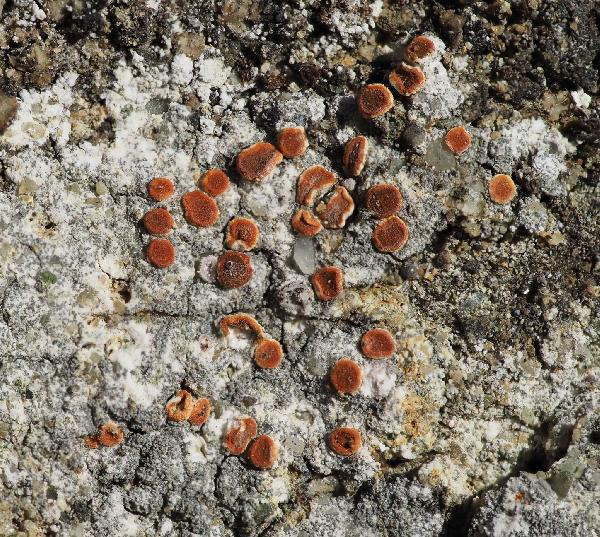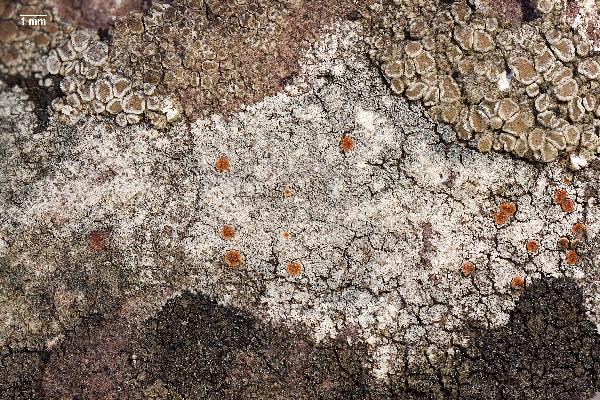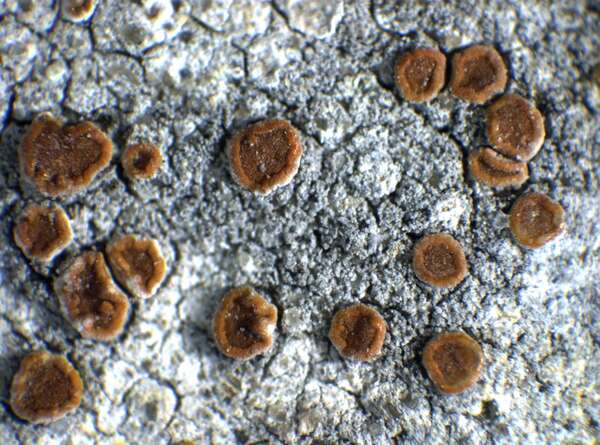Kuettlingeria albolutescens (Nyl.) I.V. Frolov, Vondrák & Arup
in Frolov & al., J. Syst. Evol. 59, 3: 468, 2020 . Basionym: Lecanora albolutescens Nyl. - Flora, 64: 127, 1909.
Synonyms: Callopisma albolutescens (Nyl.) Walt. Watson; Caloplaca albolutescens (Nyl.) H. Olivier; Placodium albolutescens (Nyl.) A.L. Sm.; Pyrenodesmia albolutescens (Nyl.) S. Y. Kondr.
Distribution: N - Frl, Piem (TO 3078). C - Tosc (Frolov & al. 2020). S - Si (Herb. Vondrák 10862).
Description: Thallus crustose to subleprose, episubstratic, granular and powdery, up to 200 μm thick, not lobed at margins, completely ecorticate, whitish to grey, forming orbicular, up to a few cm wide patches, several thalli often merging to cover larger surfaces. Center of thallus covered in abundant, grey, diffuse, granular soredia. Thallus surface and medulla with numerous colourless crystals insoluble in K, visible under polarized light. Apothecia zeorine, often numerous, circular to often irregular in outline, sessile, 0.5-1 mm across, with a flat, rust-red disc, a prominent, orange (paler than disc) proper margin, and sometimes a thin, soon disappearing thalline margin. Thalline exciple thin, rich in algae; proper exciple up to 85 µm thick, prosoplectenchymatous; epithecium brown-orange, K+ purple-red, C+ purple; hymenium colourless 70-95 µm high; paraphyses richly branched in upper part, c. 1.5 μm thick at base, the apical cells up to 3.5 μm wide; hypothecium colourless, prosoplectenchymatous. Asci 8-spored, cylindrical-clavate, functionally unitunicate, apically thickened with a broad internal beak, the inner part of apex and external cap I+ blue, Teloschistes-type. Ascospores 2-celled, polarilocular, hyaline, ellipsoid, (13-)15-18(-20) x 7-10(-12) μm, the equatorial thickening (“septum”) usually <4 μm thick (up to 1/4-1/5 of spore length). Photobiont chlorococcoid. Spot tests: thallus K- or K+ violet in sorediate parts, C-, KC-, P-, N+ violet in sorediate parts; apothecia K+ and C+ purple-red. Chemistry: soredia with the Sedifolia-grey pigment: apothecia with chlorinated anthraquinones in both margin and disc: 7-chloroemodin (major), fragilin and emodin (minor), sometimes traces of parietin. Note: this species is ecologically and morphologically very similar to K. teicholyta. It has a thin leprose thallus, the cortex is absent or poorly differentiated at margins, and marginal lobes are missing, whereas K. teicholyta has a rather thick thallus which is sorediate in the centre, while marginal lobes are more or less present and the cortex is well-developed, at least marginally.
Growth form: Crustose
Substrata: rocks
Photobiont: green algae other than Trentepohlia
Reproductive strategy: mainly asexual, by soredia, or soredia-like structures (e.g. blastidia)
Commonnes-rarity: (info)
Alpine belt: absent
Subalpine belt: absent
Oromediterranean belt: absent
Montane belt: absent
Submediterranean belt: very rare
Padanian area: absent
Humid submediterranean belt: very rare
Humid mediterranean belt: absent
Dry mediterranean belt: absent

Predictive model
Herbarium samples
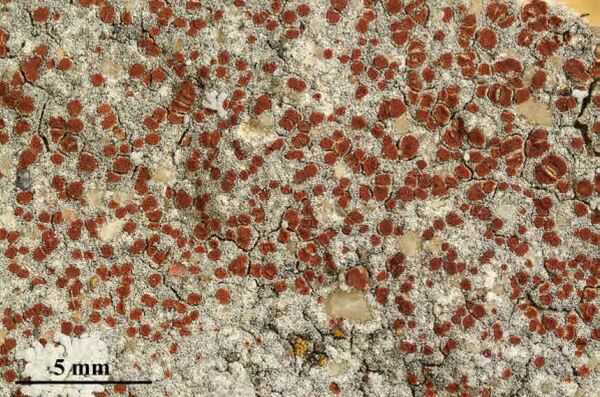

Felix Schumm - CC BY-SA 4.0
[19546], Tunesien, Karthago, an Mauern der Thermen des Antonius Pius. Leg. F. Schumm 11.03.1973, det. A. Aptroot 2016.
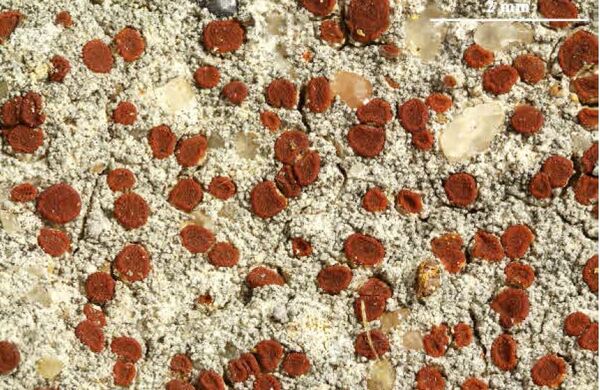

Felix Schumm - CC BY-SA 4.0
[19546], Tunesien, Karthago, an Mauern der Thermen des Antonius Pius. Leg. F. Schumm 11.03.1973, det. A. Aptroot 2016.
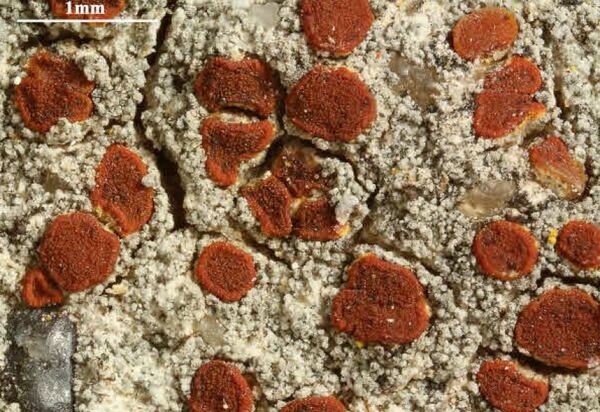

Felix Schumm - CC BY-SA 4.0
[19546], Tunesien, Karthago, an Mauern der Thermen des Antonius Pius. Leg. F. Schumm 11.03.1973, det. A. Aptroot 2016.


Felix Schumm - CC BY-SA 4.0
[19546], Tunesien, Karthago, an Mauern der Thermen des Antonius Pius. Leg. F. Schumm 11.03.1973, det. A. Aptroot 2016.
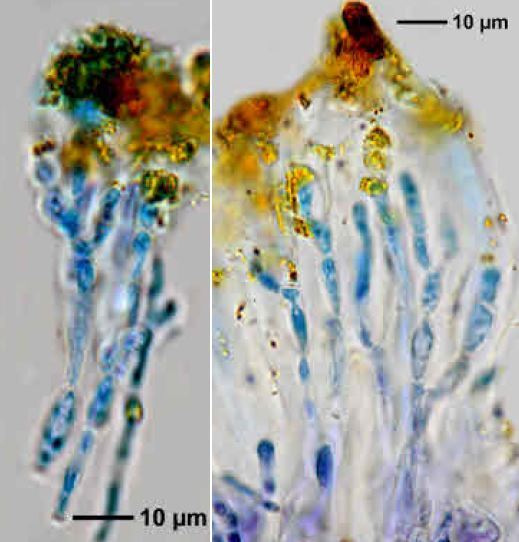

Felix Schumm - CC BY-SA 4.0
[19546], Tunesien, Karthago, an Mauern der Thermen des Antonius Pius. Leg. F. Schumm 11.03.1973, det. A. Aptroot 2016.
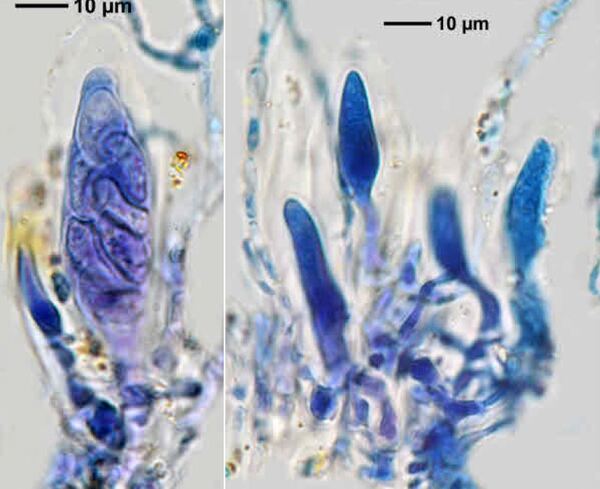

Felix Schumm - CC BY-SA 4.0
[19546], Tunesien, Karthago, an Mauern der Thermen des Antonius Pius. Leg. F. Schumm 11.03.1973, det. A. Aptroot 2016.
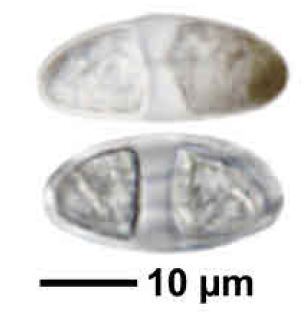

Felix Schumm - CC BY-SA 4.0
[19546], Tunesien, Karthago, an Mauern der Thermen des Antonius Pius. Leg. F. Schumm 11.03.1973, det. A. Aptroot 2016.
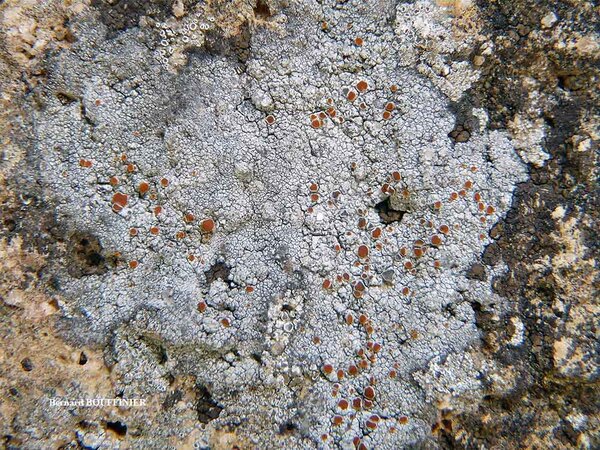
Bernard Bouffinier - Source: http://www.lichensmaritimes.org/index.php?task=fiche&lichen=673&lang=en
France, Mur de Chapelle Argol
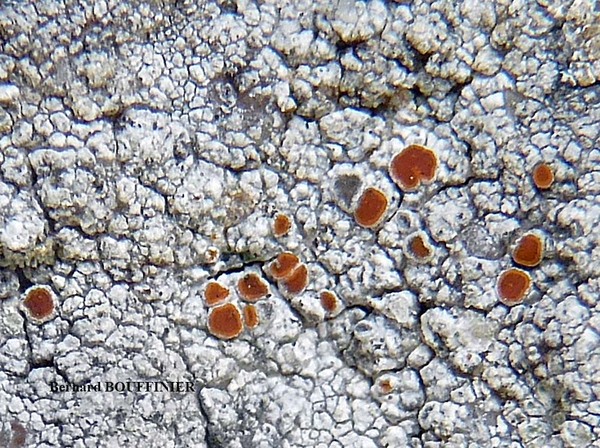
Bernard Bouffinier - Source: http://www.lichensmaritimes.org/index.php?task=fiche&lichen=673&lang=en
France, Mur de Chapelle Argol
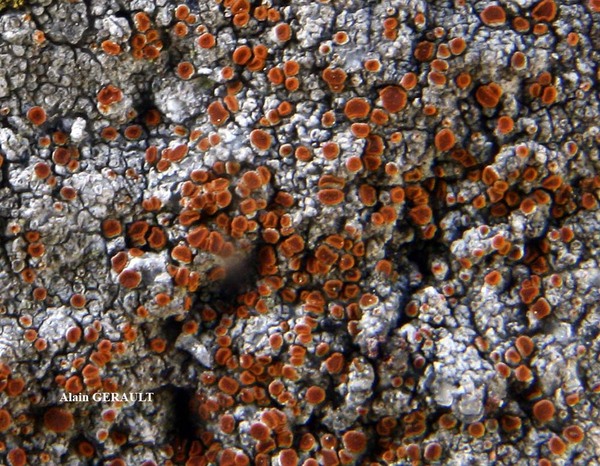
Bernard Bouffinier - Source: http://www.lichensmaritimes.org/index.php?task=fiche&lichen=673&lang=en
France, Mur de Chapelle Argol
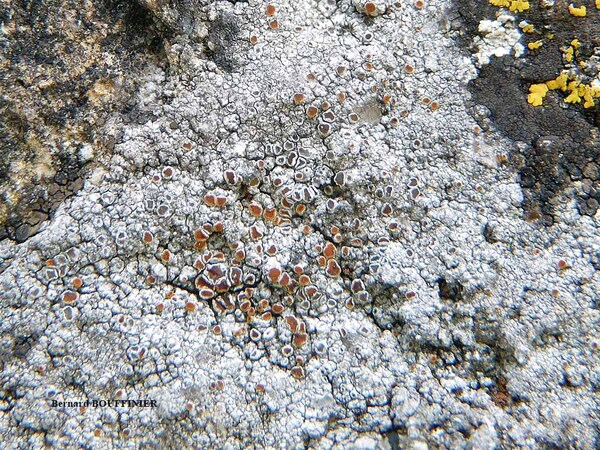
Bernard Bouffinier - Source: http://www.lichensmaritimes.org/index.php?task=fiche&lichen=673&lang=en
France, Mur de Chapelle Argol
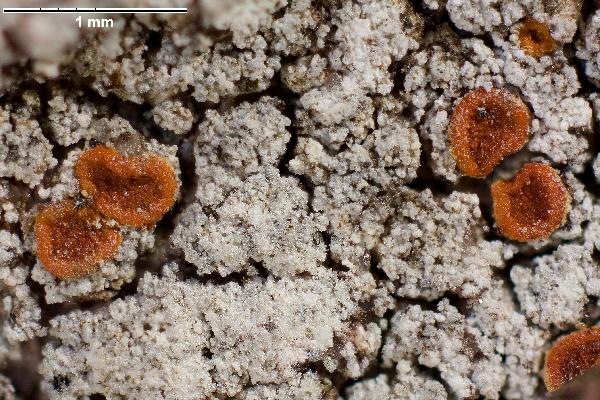
Ulrich Kirschbaum CC BY-SA 4.0 - Source: https://www.thm.de/lse/ulrich-kirschbaum/flechtenbilder
Saxicolous; on sandstone (contaminated by limestone).
Central Europe; Germany; Bavaria: Markt-Heidenfeld.
(Coll/ident M. Schessl).
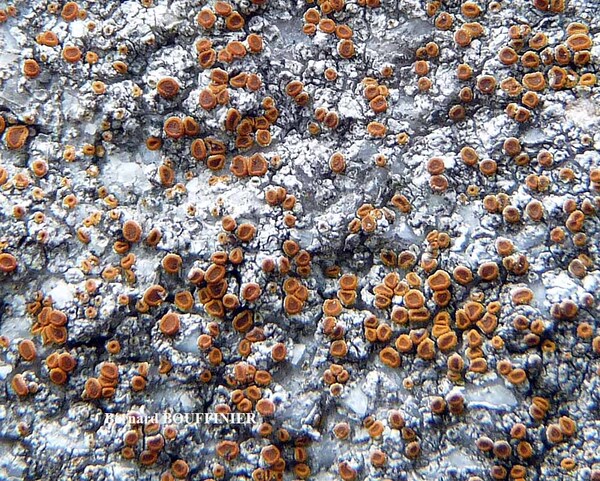
Bernard Bouffinier - Source: http://www.lichensmaritimes.org/index.php?task=fiche&lichen=673&lang=en
France, Mur de Chapelle Argol

Bernard Bouffinier - Source: http://www.lichensmaritimes.org/index.php?task=fiche&lichen=673&lang=en
France, Mur de Chapelle Argol
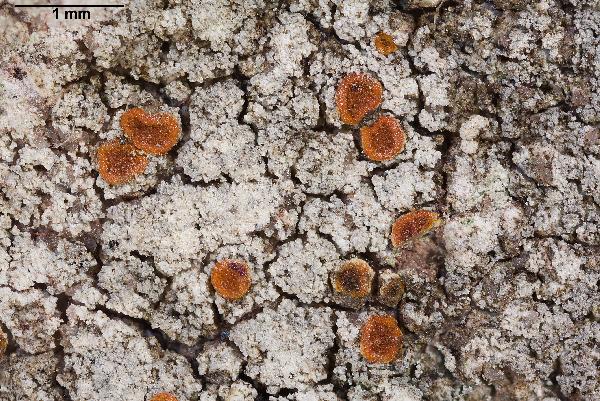
Ulrich Kirschbaum CC BY-SA 4.0 - Source: https://www.thm.de/lse/ulrich-kirschbaum/flechtenbilder
Saxicolous; on sandstone (contaminated by limestone).
Central Europe; Germany; Bavaria: Markt-Heidenfeld.
(Coll/ident M. Schessl).
Growth form: Crustose
Substrata: rocks
Photobiont: green algae other than Trentepohlia
Reproductive strategy: mainly asexual, by soredia, or soredia-like structures (e.g. blastidia)
Commonnes-rarity: (info)
Alpine belt: absent
Subalpine belt: absent
Oromediterranean belt: absent
Montane belt: absent
Submediterranean belt: very rare
Padanian area: absent
Humid submediterranean belt: very rare
Humid mediterranean belt: absent
Dry mediterranean belt: absent

Predictive model
| Herbarium samples |


Felix Schumm - CC BY-SA 4.0
[19546], Tunesien, Karthago, an Mauern der Thermen des Antonius Pius. Leg. F. Schumm 11.03.1973, det. A. Aptroot 2016.


Felix Schumm - CC BY-SA 4.0
[19546], Tunesien, Karthago, an Mauern der Thermen des Antonius Pius. Leg. F. Schumm 11.03.1973, det. A. Aptroot 2016.


Felix Schumm - CC BY-SA 4.0
[19546], Tunesien, Karthago, an Mauern der Thermen des Antonius Pius. Leg. F. Schumm 11.03.1973, det. A. Aptroot 2016.


Felix Schumm - CC BY-SA 4.0
[19546], Tunesien, Karthago, an Mauern der Thermen des Antonius Pius. Leg. F. Schumm 11.03.1973, det. A. Aptroot 2016.


Felix Schumm - CC BY-SA 4.0
[19546], Tunesien, Karthago, an Mauern der Thermen des Antonius Pius. Leg. F. Schumm 11.03.1973, det. A. Aptroot 2016.


Felix Schumm - CC BY-SA 4.0
[19546], Tunesien, Karthago, an Mauern der Thermen des Antonius Pius. Leg. F. Schumm 11.03.1973, det. A. Aptroot 2016.


Felix Schumm - CC BY-SA 4.0
[19546], Tunesien, Karthago, an Mauern der Thermen des Antonius Pius. Leg. F. Schumm 11.03.1973, det. A. Aptroot 2016.

Bernard Bouffinier - Source: http://www.lichensmaritimes.org/index.php?task=fiche&lichen=673&lang=en
France, Mur de Chapelle Argol

Bernard Bouffinier - Source: http://www.lichensmaritimes.org/index.php?task=fiche&lichen=673&lang=en
France, Mur de Chapelle Argol

Bernard Bouffinier - Source: http://www.lichensmaritimes.org/index.php?task=fiche&lichen=673&lang=en
France, Mur de Chapelle Argol

Bernard Bouffinier - Source: http://www.lichensmaritimes.org/index.php?task=fiche&lichen=673&lang=en
France, Mur de Chapelle Argol

Ulrich Kirschbaum CC BY-SA 4.0 - Source: https://www.thm.de/lse/ulrich-kirschbaum/flechtenbilder
Saxicolous; on sandstone (contaminated by limestone). Central Europe; Germany; Bavaria: Markt-Heidenfeld. (Coll/ident M. Schessl).

Bernard Bouffinier - Source: http://www.lichensmaritimes.org/index.php?task=fiche&lichen=673&lang=en
France, Mur de Chapelle Argol

Bernard Bouffinier - Source: http://www.lichensmaritimes.org/index.php?task=fiche&lichen=673&lang=en
France, Mur de Chapelle Argol

 INDEX FUNGORUM
INDEX FUNGORUM
 GBIF
GBIF
 DOLICHENS
DOLICHENS
